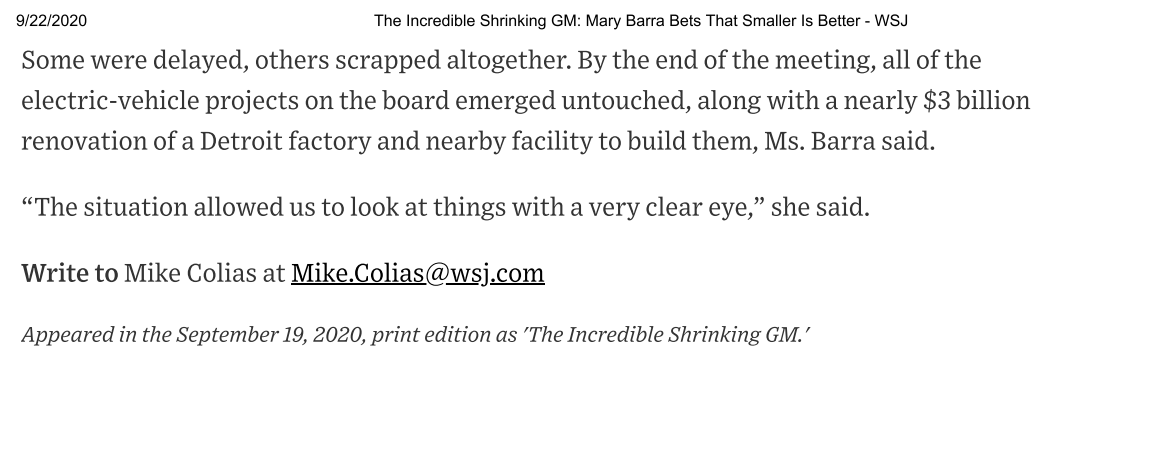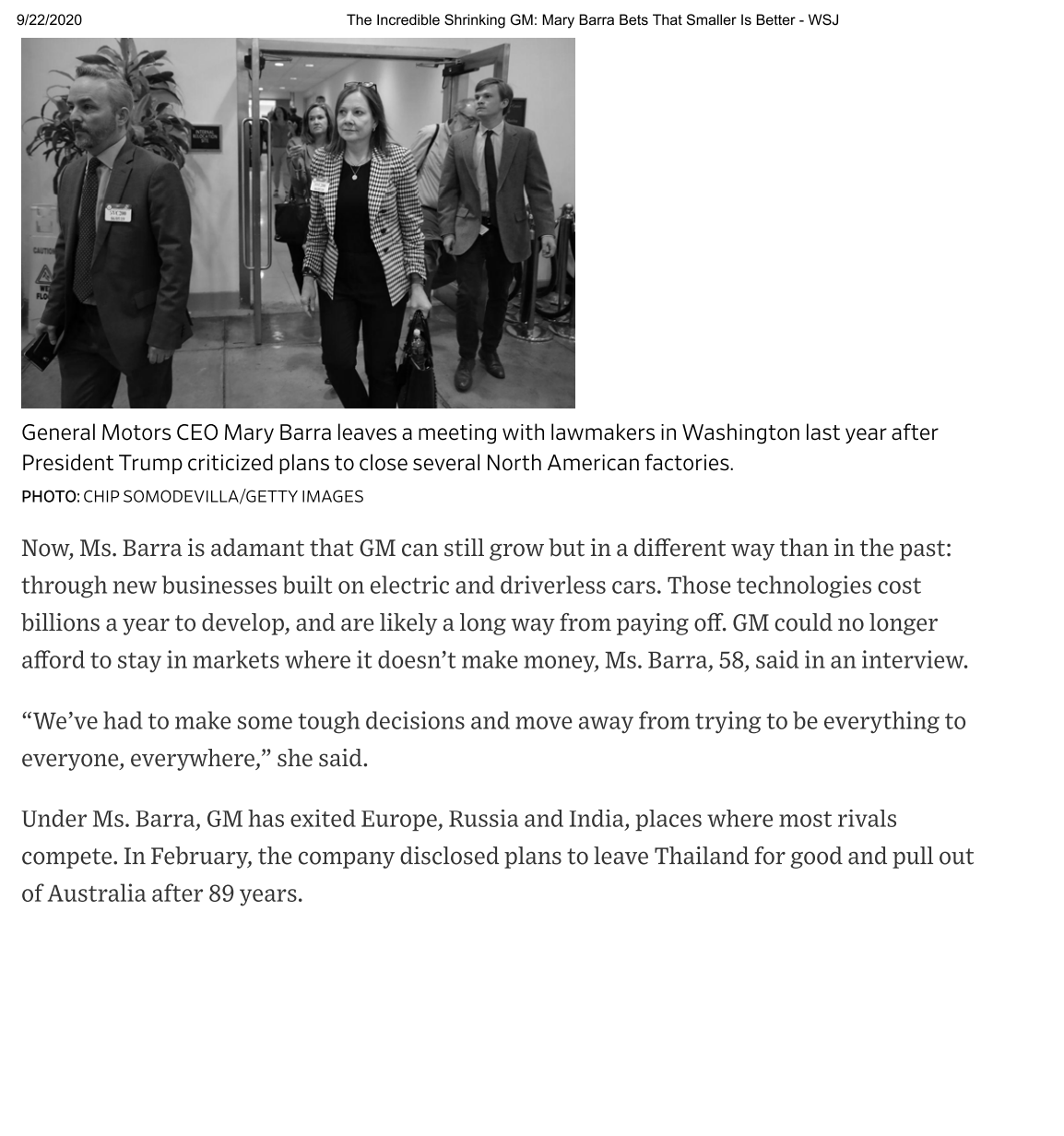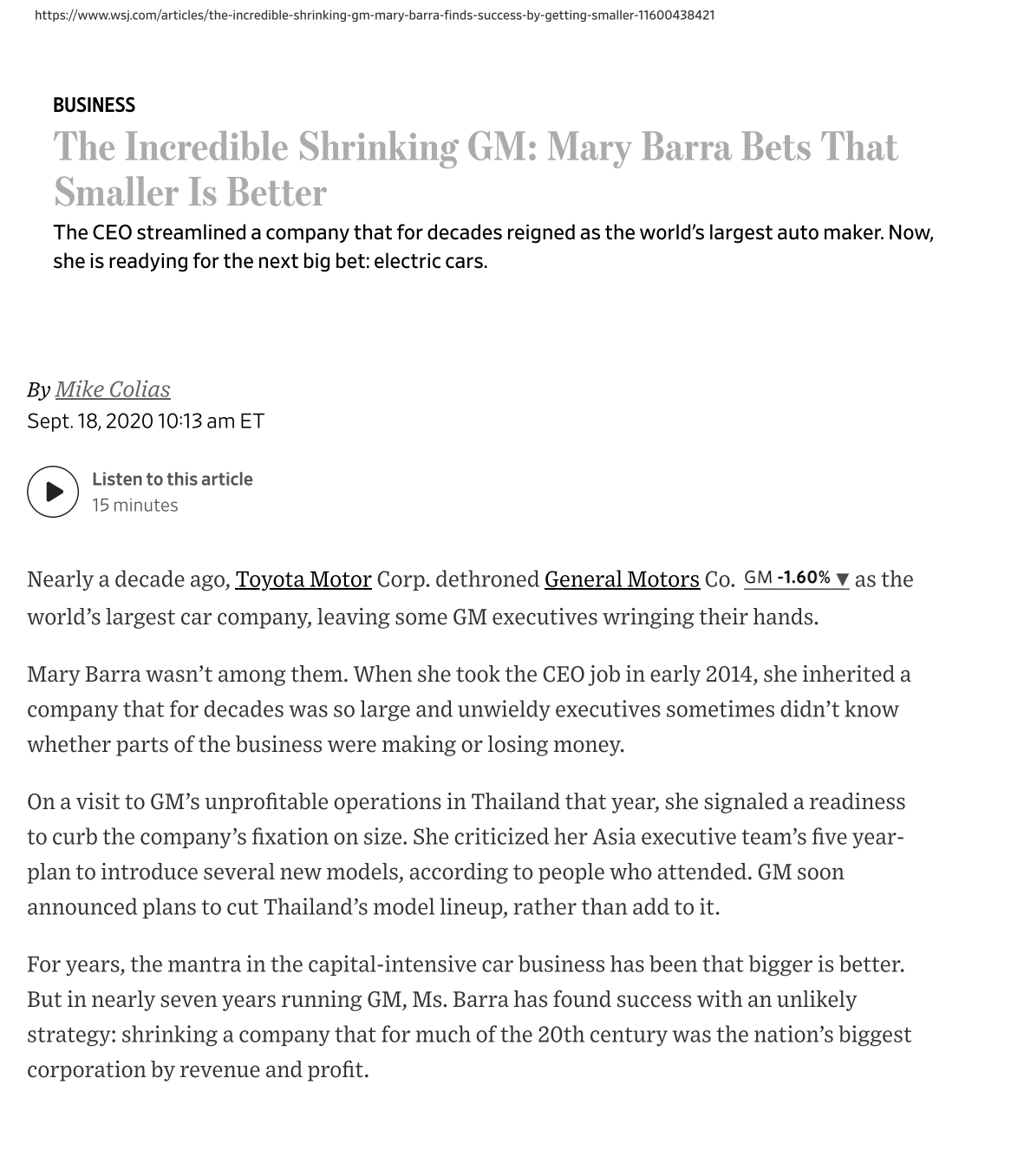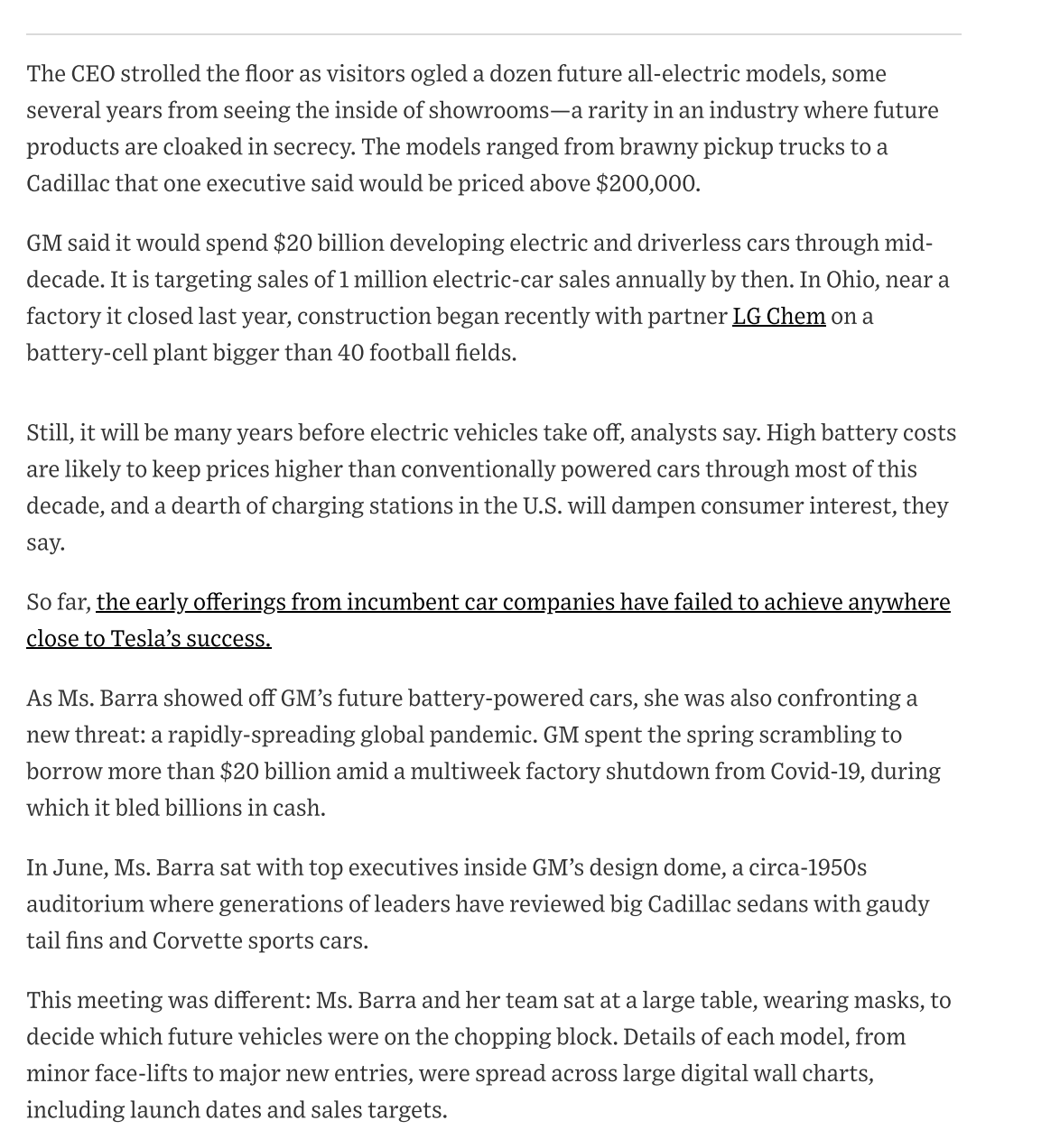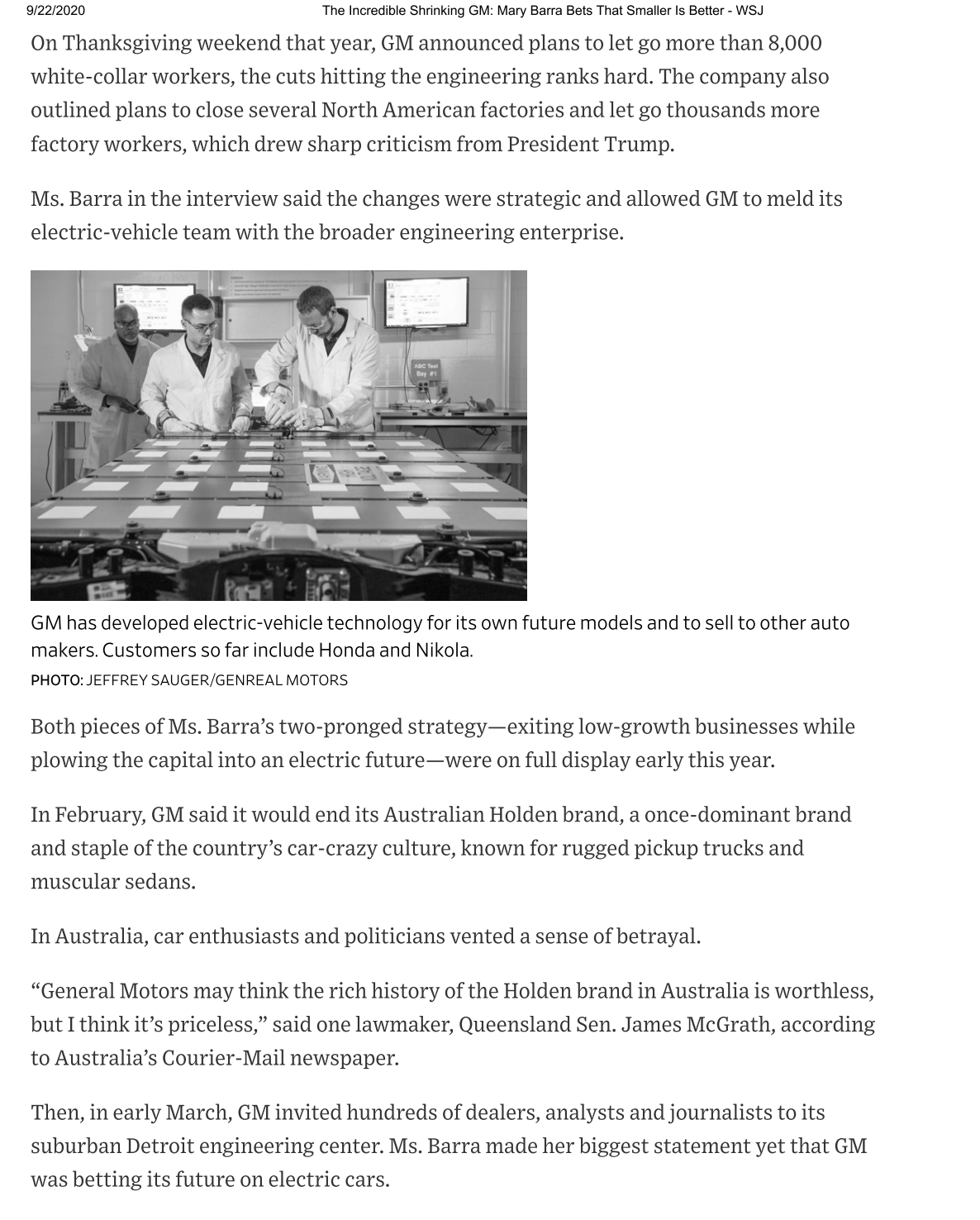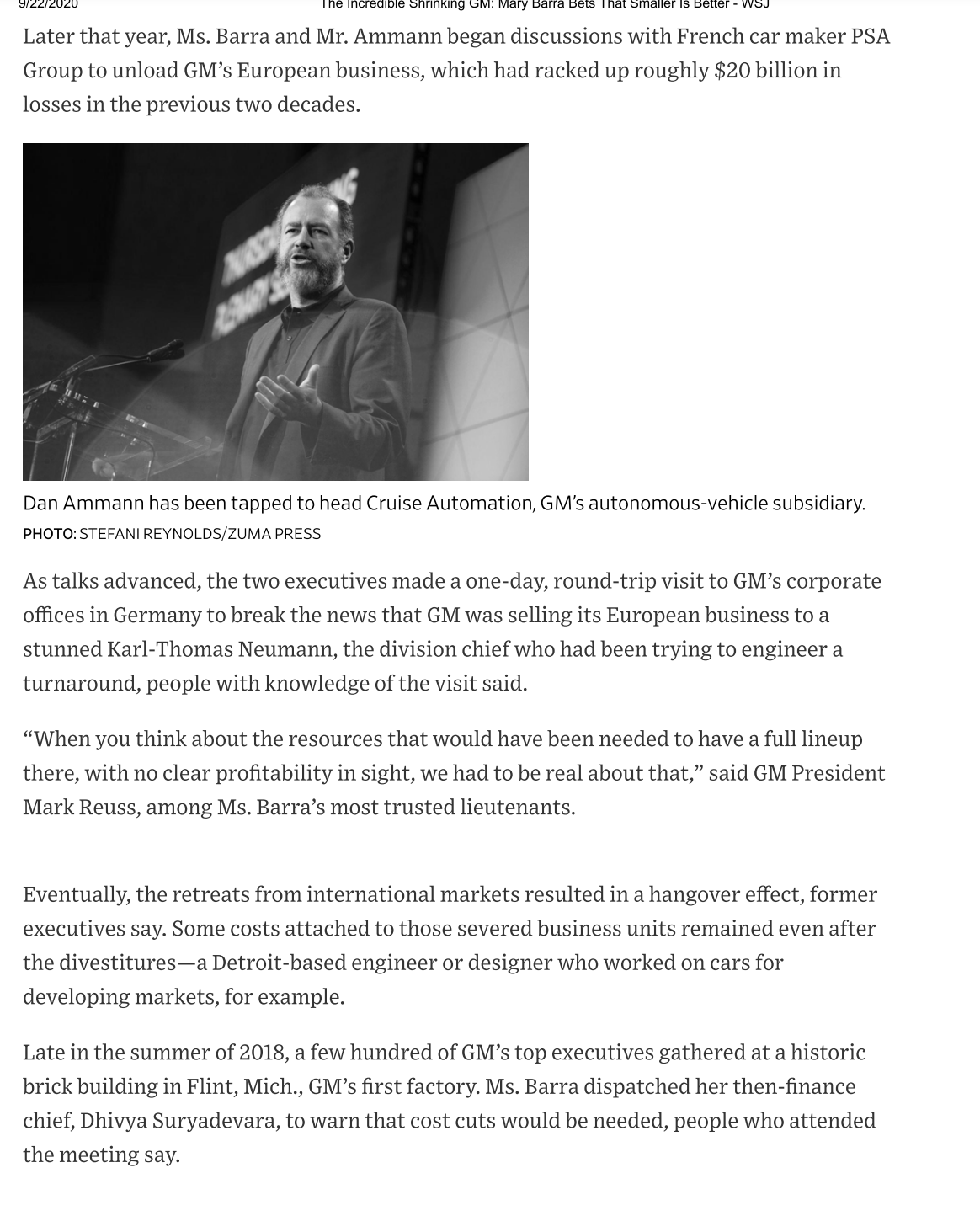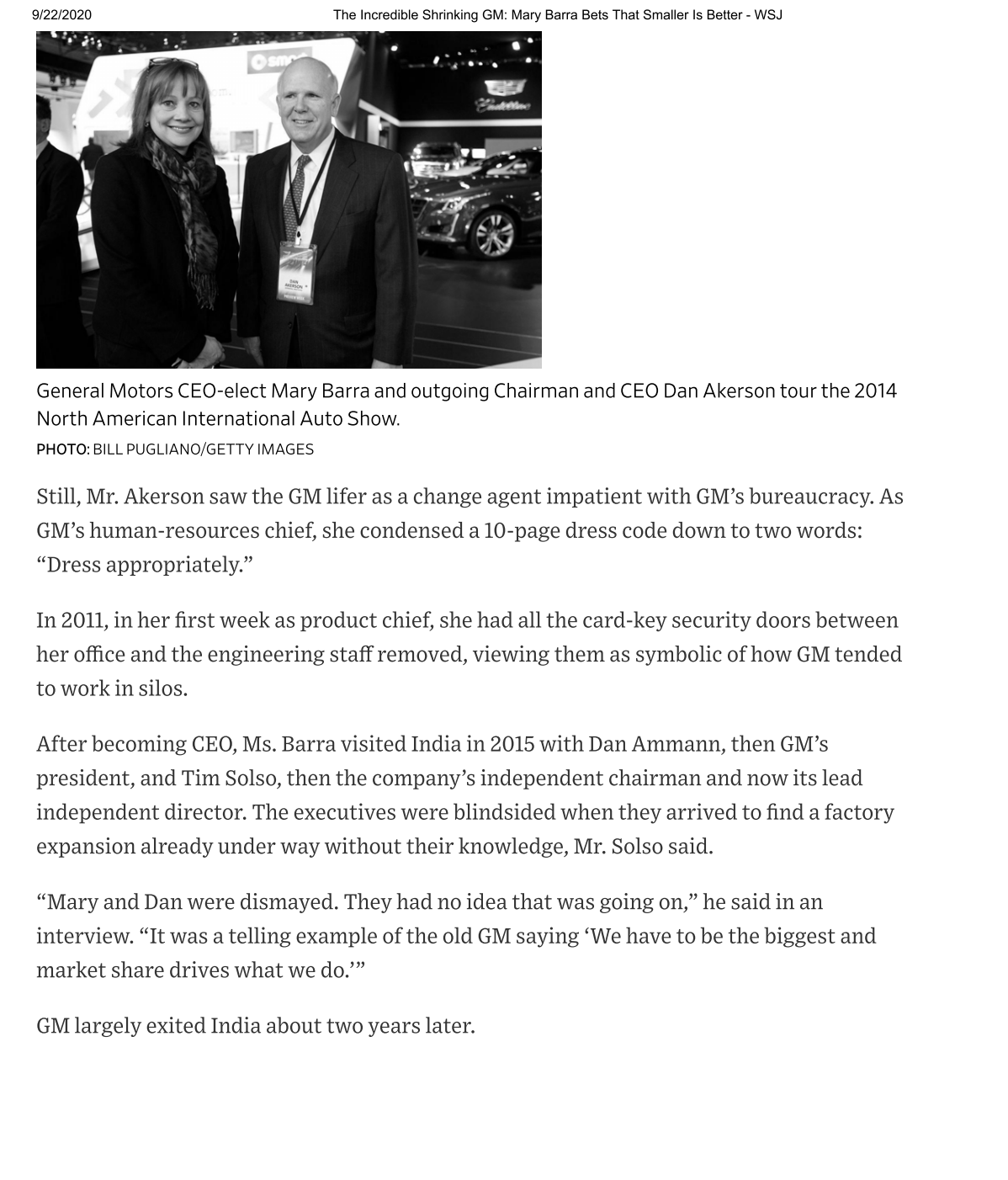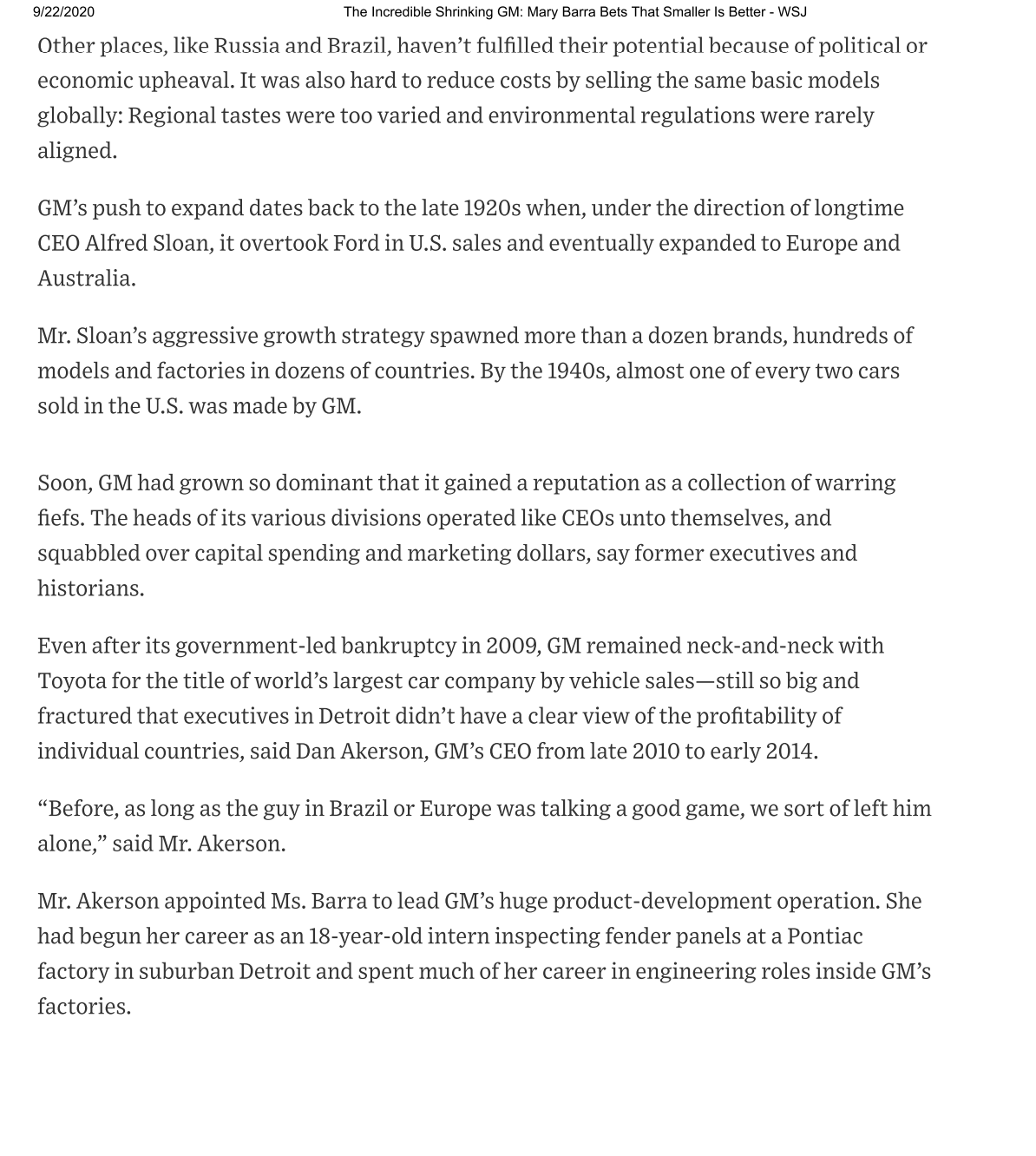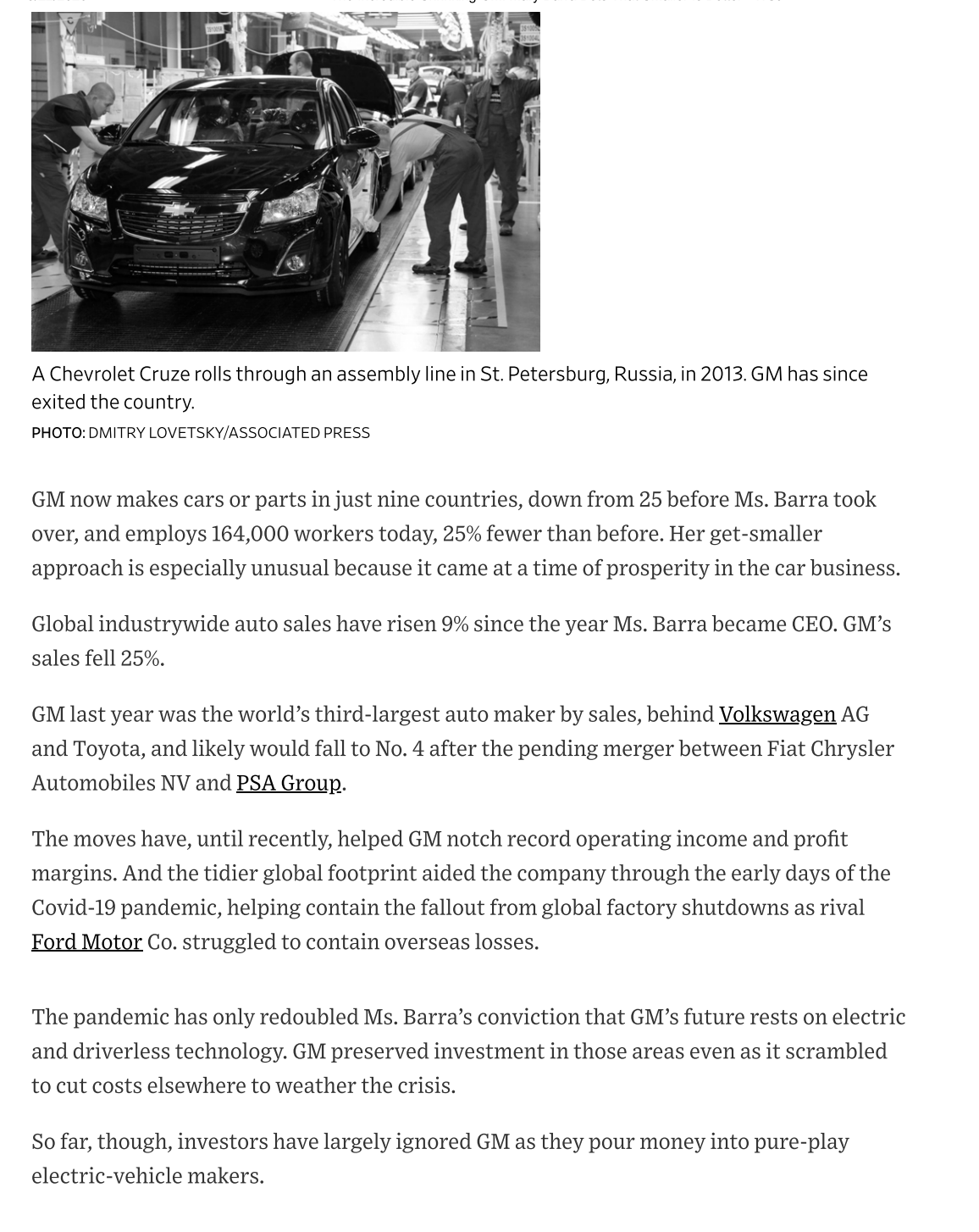After reading the article attached, what were Mary Barra's Strategies and her rationale for using them? What are the key components of the strategy implementation used throughout the case?
$222020 The Incredible Shrinking GM: Mary Barra Bets That Smaller Is Better - WSJ Some were delayed, others scrapped altogether. By the end of the meeting, all of the electricvehicle projects on the board emerged untouched, along with a nearly $3 billion renovation of a Detroit factory and nearby facility to build them, Ms. Barra said. \"The situation allowed us to look at things with a very clear eye,\" she said. Write to Mike Colias at Mike.Colias@msj.com Appeared in the September 19, 2020, print edition as 'The Incredible Shrinking GM. ' 9/22/2020 The Incredible Shrinking GM: Mary Barra Bets That Smaller Is Better - WSJ General Motors CEO Mary Barra leaves a meeting with lawmakers in Washington last year after President Trump criticized plans to close several North American factories. PHOTO: CHIP SOMODEVILLA/GETTY IMAGES Now, Ms. Barra is adamant that GM can still grow but in a different way than in the past: through new businesses built on electric and driverless cars. Those technologies cost billions a year to develop, and are likely a long way from paying off. GM could no longer afford to stay in markets where it doesn't make money, Ms. Barra, 58, said in an interview. "We've had to make some tough decisions and move away from trying to be everything to everyone, everywhere," she said. Under Ms. Barra, GM has exited Europe, Russia and India, places where most rivals compete. In February, the company disclosed plans to leave Thailand for good and pull out of Australia after 89 years.https://www.wsj.com/articles/the-incredible-shrinking-gm-mary-barra-finds-success-by-getting-smaller-11600438421 BUSINESS The Incredible Shrinking GM: Mary Barra Bets That Smaller Is Better The CEO streamlined a company that for decades reigned as the world's largest auto maker. Now, she is readying for the next big bet: electric cars. By Mike Colias Sept. 18, 2020 10:13 am ET Listen to this article 15 minutes Nearly a decade ago, Toyota Motor Corp. dethroned General Motors Co. GM -1.60% _ as the world's largest car company, leaving some GM executives wringing their hands. Mary Barra wasn't among them. When she took the CEO job in early 2014, she inherited a company that for decades was so large and unwieldy executives sometimes didn't know whether parts of the business were making or losing money. On a visit to GM's unprofitable operations in Thailand that year, she signaled a readiness to curb the company's fixation on size. She criticized her Asia executive team's five year- plan to introduce several new models, according to people who attended. GM soon announced plans to cut Thailand's model lineup, rather than add to it. For years, the mantra in the capital-intensive car business has been that bigger is better. But in nearly seven years running GM, Ms. Barra has found success with an unlikely strategy: shrinking a company that for much of the 20th century was the nation's biggest corporation by revenue and profit.The CEO strolled the oor as visitors ogled a dozen future all-electric models, some several years from seeing the inside of showroomsa rarity in an industry where future products are cloaked in secrecy. The models ranged from brawny pickup trucks to a Cadillac that one executive said would be priced above $200,000. GM said it would spend $20 billion developing electric and driverless cars through mid- decade. It is targeting sales of 1 million electric-car sales annually by then. In Ohio, near a factory it closed last year, construction began recently with partner LQ thm on a battery-cell plant bigger than 40 football elds. Still, it will be many years before electric vehicles take off, analysts say. High battery costs are likely to keep prices higher than conventionally powered cars through most of this decade, and a dearth of charging stations in the U.S. will dampen consumer interest, they say. So far, the early offerings from incumbent car companies have failed to achieve anywhere Wis. As Ms. Barra showed off GM's future battery-powered cars, she was also confronting a new threat: a rapidly-spreading global pandemic. GM spent the spring scrambling to borrow more than $20 billion amid a multiweek factory shutdown from Covid-19, during which it bled billions in cash. In June, Ms. Barra sat with top executives inside GM's design dome, a circa-19505 auditorium where generations of leaders have reviewed big Cadillac sedans with gaudy tail ns and Corvette sports cars. This meeting was different: Ms. Barra and her team sat at a large table, wearing masks, to decide which future vehicles were on the chopping block. Details of each model, from minor face-lifts to major new entries, were spread across large digital wall charts, including launch dates and sales targets. 9/22/2020 The Incredible Shrinking GM: Mary Barra Bets That Smaller Is Better - WSJ On Thanksgiving weekend that year, GM announced plans to let go more than 8,000 white-collar workers, the cuts hitting the engineering ranks hard. The company also outlined plans to close several North American factories and let go thousands more factory workers, which drew sharp criticism from President Trump. Ms. Barra in the interview said the changes were strategic and allowed GM to meld its electric-vehicle team with the broader engineering enterprise. GM has developed electric-vehicle technology for its own future models and to sell to other auto makers. Customers so far include Honda and Nikola. PHOTO: JEFFREY SAUGER/GENREAL MOTORS Both pieces of Ms. Barra's two-pronged strategy-exiting low-growth businesses while plowing the capital into an electric future-were on full display early this year. In February, GM said it would end its Australian Holden brand, a once-dominant brand and staple of the country's car-crazy culture, known for rugged pickup trucks and muscular sedans. In Australia, car enthusiasts and politicians vented a sense of betrayal. "General Motors may think the rich history of the Holden brand in Australia is worthless, but I think it's priceless," said one lawmaker, Queensland Sen. James McGrath, according to Australia's Courier-Mail newspaper. Then, in early March, GM invited hundreds of dealers, analysts and journalists to its suburban Detroit engineering center. Ms. Barra made her biggest statement yet that GM was betting its future on electric cars.Later that year, Ms. Barra and Mr. Ammann began discussions with French car maker PSA Group to unload GM's European business, which had racked up roughly $20 billion in losses in the previous two decades. Dan Ammann has been tapped to head Cruise Automation, GM's autonomous-vehicle subsidiary. PHOTO: STEFANI REYNOLDS/ZUMA PRESS As talks advanced, the two executives made a one-day, round-trip visit to GM's corporate offices in Germany to break the news that GM was selling its European business to a stunned Karl-Thomas Neumann, the division chief who had been trying to engineer a turnaround, people with knowledge of the visit said. "When you think about the resources that would have been needed to have a full lineup there, with no clear profitability in sight, we had to be real about that," said GM President Mark Reuss, among Ms. Barra's most trusted lieutenants. Eventually, the retreats from international markets resulted in a hangover effect, former executives say. Some costs attached to those severed business units remained even after the divestitures-a Detroit-based engineer or designer who worked on cars for developing markets, for example. Late in the summer of 2018, a few hundred of GM's top executives gathered at a historic brick building in Flint, Mich., GM's first factory. Ms. Barra dispatched her then-finance chief, Dhivya Suryadevara, to warn that cost cuts would be needed, people who attended the meeting say.9/22/2020 The Incredible Shrinking GM: Mary Barra Bets That Smaller Is Better - WSJ UP 70 DF 3215 A Chevrolet model parked at a market in Allahabad, India, in 2017. GM has pulled the brand out of the country. PHOTO: RAJESH KUMAR SINGH/ASSOCIATED PRESS Around that same time, a confluence of forces was beginning to disrupt the car business. Alphabet Inc.'s Google in 2015 tested a self-driving car on public roads. Apple Inc. was rumored to be developing a car. Ride-hailing services like Uber were becoming mainstream. Ms. Barra, who got her M.B.A. at Stanford University, that year arranged a week-long trip to Silicon Valley with her top executives. They chatted with Apple CEO Tim Cook and his team about industry disruption for a few hours, the people said. They discussed autonomous-driving technology with Google brass. Once back in Detroit, Ms. Barra scheduled workshops to sketch out a growth strategy for GM, based on an evolving view that the future would hinge on offering alternative ways for people to get around, such as electric and self-driving cars, said John Quattrone, Ms. Barra's human-resources chief before his retirement in 2017. That would also mean deeper cuts overseas to fund the future, Mr. Quattrone said. Ms. Barra presented the new vision to nearly 300 executives at GM's proving grounds in suburban Detroit, an expanse of green meadows and ribbons of asphalt where camouflaged future models buzz around test tracks. "We all have to sign up for this plan. If you don't believe in it, then see John and we'll find a landing spot for you," Ms. Barra said, according to Mr. Quattrone.9/22/2020 The Incredible Shrinking GM: Mary Barra Bets That Smaller Is Better - WSJ Os General Motors CEO-elect Mary Barra and outgoing Chairman and CEO Dan Akerson tour the 2014 North American International Auto Show. PHOTO: BILL PUGLIANO/GETTY IMAGES Still, Mr. Akerson saw the GM lifer as a change agent impatient with GM's bureaucracy. As GM's human-resources chief, she condensed a 10-page dress code down to two words: "Dress appropriately." In 2011, in her first week as product chief, she had all the card-key security doors between her office and the engineering staff removed, viewing them as symbolic of how GM tended to work in silos. After becoming CEO, Ms. Barra visited India in 2015 with Dan Ammann, then GM's president, and Tim Solso, then the company's independent chairman and now its lead independent director. The executives were blindsided when they arrived to find a factory expansion already under way without their knowledge, Mr. Solso said. "Mary and Dan were dismayed. They had no idea that was going on," he said in an interview. "It was a telling example of the old GM saying 'We have to be the biggest and market share drives what we do.'" GM largely exited India about two years later.9/22/2020 The Incredible Shrinking GM: Mary Barra Bets That Smaller Is Better - WSJ Other places, like Russia and Brazil, haven't fulfilled their potential because of political or economic upheaval. It was also hard to reduce costs by selling the same basic models globally: Regional tastes were too varied and environmental regulations were rarely aligned. GM's push to expand dates back to the late 1920s when, under the direction of longtime CEO Alfred Sloan, it overtook Ford in U.S. sales and eventually expanded to Europe and Australia. Mr. Sloan's aggressive growth strategy spawned more than a dozen brands, hundreds of models and factories in dozens of countries. By the 1940s, almost one of every two cars sold in the U.S. was made by GM. Soon, GM had grown so dominant that it gained a reputation as a collection of warring fiefs. The heads of its various divisions operated like CEOs unto themselves, and squabbled over capital spending and marketing dollars, say former executives and historians. Even after its government-led bankruptcy in 2009, GM remained neck-and-neck with Toyota for the title of world's largest car company by vehicle sales-still so big and fractured that executives in Detroit didn't have a clear view of the profitability of individual countries, said Dan Akerson, GM's CEO from late 2010 to early 2014. "Before, as long as the guy in Brazil or Europe was talking a good game, we sort of left him alone," said Mr. Akerson. Mr. Akerson appointed Ms. Barra to lead GM's huge product-development operation. She had begun her career as an 18-year-old intern inspecting fender panels at a Pontiac factory in suburban Detroit and spent much of her career in engineering roles inside GM's factories.9l22l'2020 The Incredible Shrinking GM: Mary Barra Bets That Smaller Is Better - WSJ Tesla Inc. shares have soared this year to make it the world's most valuable car company. Startups are snapping up billions of dollars in private investment or recently-launched IPOs, including truck makers Rivian Automotive and Nikola Corp. Shares of GM and Nikola surged last week following a deal for GM to engineer and build trucks for the startup. Nikola shares have since fallen sharply after a short seller's allegations that it exaggerated the progress of its technology, drawing investigations by U.S. seeerities regulators and the ,Jestiee Department, Nikola has denied the claims. Ms. Barra has said GM did its due diligence. GM shares remain stuck below the $33 IPO price from a decade ago. Ms. Barra's retrenchment strategy has been anathema for some inside GM, a company long hard-wired to pursue international growth. Some former GM executives question whether Ms. Barra is leaving GM too dependent on the U.S. and China and unable to capitalize on the moment if India or other developing markets take off. For decades at GM, executive stints in overseas markets like Brazil and China were highly sought after and considered unofcial prerequisites for the C-suite, said Bob Lutz, a former GM vice chairman who ran product development from 2001 to 2009. There also was pride in retaining the world's biggest auto maker title, he said. Mr. Lutz recalls a TV interview from around 2005, when he was asked about the possibility of Toyota surpassing GM. He expressed indifference. Later that day, then-GEO Rick Wagoner called Mr. Lutz into his ofce. \"He said, 'Bob, we've got to get our messages together. I happen to believe there is unbelievable value in being the world's biggest,' \" Mr. Lutz recalls. Mr. Wagoner declined to comment. The super-size argument goes like this: The bigger a car company's sales globally, the greater its cost advantages, with the ability to command better terms from suppliers, whether on engine parts or ad campaigns. For GM, expanding into untapped markets overseas was a shortcut to revenue growth. But markets such as China have become ercely competitive, pressuring prot margins. A Chevrolet Cruze rolls through an assembly line in St. Petersburg, Russia, in 2013. GM has since exited the country. PHOTO: DMITRY LOVETSKYIASSOCIATED PRESS GM now makes cars or parts in just nine countries, down from 25 before Ms. Barra took over, and employs 164,000 workers today, 25% fewer than before. Her get-smaller approach is especially unusual because it came at a time of prosperity in the car business. Global industrywide auto sales have risen 9% since the year Ms. Barra became CEO. GM's sales fell 25%. GM last year was the world's third-largest auto maker by sales, behind Volkswagtm AG and Toyota, and likely would fall to No. 4 after the pending merger between Fiat Chrysler Automobiles NV and PSA Group. The moves have, until recently, helped GM notch record operating income and prot margins. And the tidier global footprint aided the company through the early days of the Covid-19 pandemic, helping contain the fallout from global factory shutdowns as rival MMDIQI Co. struggled to contain overseas losses. The pandemic has only redoubled Ms. Barra's conviction that GM's future rests on electric and driverless technology. GM preserved investment in those areas even as it scrambled to cut costs elsewhere to weather the crisis. So far, though, investors have largely ignored GM as they pour money into pure-play electricvehicle makers
